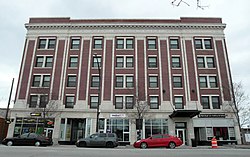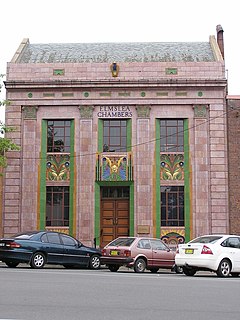
Glazed architectural terra-cotta is a ceramic masonry building material used as a decorative skin. It has been popular in the United States from the late 19th century until the 1930s, and still one of the most common building materials found in U.S. urban environments. It is the glazed version of architectural terracotta; the material in both its glazed and unglazed versions is sturdy and relatively inexpensive, and can be molded into richly ornamented detail. Glazed terra-cotta played a significant role in architectural styles such as the Chicago School and Beaux-Arts architecture.

The Reliance Building is a skyscraper located at 1 W. Washington Street in the Loop community area of Chicago, Illinois. The first floor and basement were designed by John Root of the Burnham and Root architectural firm in 1890, with the rest of the building completed by Charles B. Atwood in 1895. It is the first skyscraper to have large plate glass windows make up the majority of its surface area, foreshadowing a design feature that would become dominant in the 20th century.

The Blackstone Hotel is a historic 290-foot (88 m) 21-story hotel on the corner of Michigan Avenue and Balbo Drive in the Michigan Boulevard Historic District in the Loop community area of Chicago, Illinois. Built between 1908 and 1910, it is on the National Register of Historic Places. The Blackstone is famous for hosting celebrity guests, including numerous U.S. presidents, for which it was known as the "Hotel of Presidents" for much of the 20th century, and for contributing the term "smoke-filled room" to political parlance.

The Shoreland is a historic hotel building in the Hyde Park neighborhood of Chicago, Illinois. It was added to the United States National Register of Historic Places in 1986. Opened in the 1920s, it served hotel guests in luxury accommodations. Later, it was as a residence hall of the University of Chicago for many years, before being converted to an apartment building in 2013.
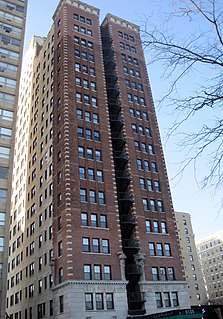
The Flamingo-on-the-Lake Apartments, also known as the Flamingo Apartment Hotel, is a building designed by architect William C. Reichert and located at 5500-5520 S. Shore Drive along Lake Michigan in the Hyde Park neighborhood of Chicago, Illinois. The 16-story apartment building was built with 144 apartments and 16 hotel rooms in 1927; it also featured an outdoor pool and bathhouse. It was designed in the Classical Revival style; its exterior is red brick with terra cotta ornamentation and a dentillated cornice. It and the adjacent building, The Promontory Apartments, a co-op building designed by Mies van der Rohe, are the furthest east buildings in Hyde Park.

The Belcrest Apartments is an apartment building located at 5440 Cass Avenue in Midtown Detroit, Michigan. It was built in 1926 as the Belcrest Hotel, designated a Michigan State Historic Site in 1983, and listed on the National Register of Historic Places in 1984. It is significant as an early example of the apartment hotel development concept in Detroit, and a major early work of architect Charles N. Agree.
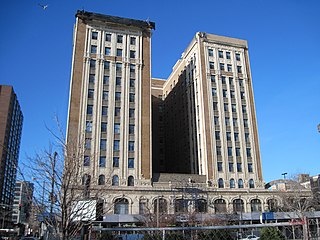
The Sheridan Plaza Hotel is a historic hotel located at the corner of Wilson Avenue and Sheridan Road in the Uptown neighborhood of Chicago, Illinois.
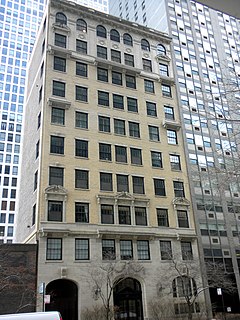
The Building at 257 East Delaware is a historic apartment building located at 257 East Delaware Place in the Near North Side neighborhood of Chicago, Illinois. The building was built in 1917 during a wave of luxury apartment construction on the Near North Side. Architect John Nyden designed the Renaissance Revival building, which was one of Chicago's first luxury apartments designed in the style. Like most skyscrapers of the area, the ten-story building is split into three parts visually; the upper two and lower two floors are faced with terra cotta and are connected by a brick shaft. The building is topped with a cornice and balustrade. Terra cotta lintels and decorations add an Adamesque influence to the building.

The Carling Hotel is a historic residential hotel located at 1512 N. LaSalle Street in the Near North Side neighborhood of Chicago, Illinois. Built in 1927, the hotel was one of many residential hotels constructed to house an influx of labor to Chicago in the early 20th century. While the hotel offered rooms to both temporary and permanent residents, census records indicate that most of its residents were permanent. Architect Edmund J. Meles, who designed several large hotels and apartment buildings in Chicago, designed the building in a blend of the Classical Revival and Renaissance Revival styles. The brick building features extensive terra cotta ornamentation, including entrance and window surrounds, pilasters, and a molded cornice above the first floor.

The Union Park Hotel is a historic hotel building located at 1519-1521 W. Warren Boulevard in Chicago, Illinois. The building was built in 1929-30 as an apartment hotel, a common type of housing for Chicago laborers in the 1920s. The hotel's Art Deco design reflects the national popularity of the style in the 1920s. The building's piers give it a vertical emphasis common to Art Deco works, and its decorative elements reflect the style's geometric focus. The colorful brick and terra cotta facade of the building is also characteristic of Art Deco buildings of the late 1920s, though color is seldom used extensively in Chicago's other Art Deco buildings.

The Lindemann and Hoverson Company Showroom and Warehouse is a historic industrial building at 2620 W. Washington Boulevard in the East Garfield Park neighborhood of Chicago, Illinois. The Lindemann and Hoverson Company, which manufactured heaters, stoves, and electric kitchen tools, built the building in 1924. Architect Paul Gerhardt, Sr., designed the industrial loft; while such buildings were often plain structures, his design is more formal and includes ornamentation. The building's showroom section, which encompasses the first two floors on the west side, is clad with a terra cotta section which features pilasters and a frieze. The remainder of the building has a brick exterior, though it includes terra cotta medallions and a cornice. Lindemann and Hoverson occupied the building until 1941.

The Hotel Del Prado is a historic apartment hotel at 5307 S. Hyde Park Boulevard in the Hyde Park neighborhood in Chicago, Illinois. Built in 1918, it is the oldest of the several apartment hotels built in Hyde Park in the late 1910s and 1920s. Hyde Park was growing in both population and prestige at the time, creating a need for additional housing. Apartment hotels were a fashionable choice, as they combined the amenities and prestige of hotels with the affordability of apartments. The Hotel Del Prado had 198 apartments and included commercial space on its first and second floors. Its Neoclassical design includes Palladian windows on its lower floors, terra cotta trim throughout its exterior, and carved American Indian heads atop terra cotta columns.
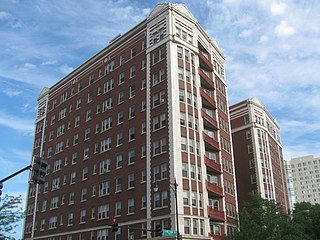
The East Park Towers are a historic apartment building at 5236-5252 S. Hyde Park Boulevard in the Hyde Park neighborhood of Chicago, Illinois. The building was constructed in 1922-23 during a period of residential growth in Hyde Park. While it had no guest rooms, the apartments offered similar amenities to an apartment hotel, such as housekeeping service. Apartment hotels were popular as part-time housing for wealthy workers, as they combined the amenities of in-home service with the affordability of apartments, and the East Park Towers were one of several such apartments built in Hyde Park at the time. Architect William P. Doerr designed the building in the Georgian Revival style; his design included terra cotta belt courses and quoins and Palladian windows on the first floor.
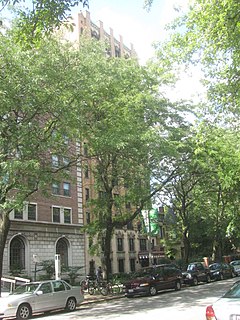
The Poinsettia Apartments are an apartment hotel at 5528 S. Hyde Park Boulevard in the Hyde Park neighborhood of Chicago, Illinois. Built in 1929, the building was the last of several apartment hotels built in Hyde Park during a period of residential development in the late 1910s and 1920s. Apartment hotels were popular among wealthier workers in the city at the time, as they combined the amenities and prestige of hotels with the affordability of apartments. The Poinsettia Apartments were both the smallest of the Hyde Park apartment hotels and the only building designed in the Spanish Colonial Revival style. Its design features pilasters spanning the height of the building, terra cotta ornamentation, and decorative window surrounds on the first two floors.
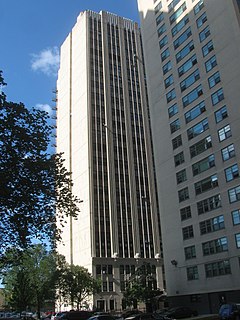
The Narragansett is a historic apartment building at 1640 E. 50th Street in the Kenwood neighborhood of Chicago, Illinois. The building was built in 1928 at the peak of apartment construction in Chicago, as apartments had grown in popularity throughout the early 20th century. It was one of several apartments built in the Chicago Beach Development, a lakefront property that was developed into a fashionable neighborhood known as Indian Village. Architects Leichenko and Esser designed the Art Deco building. The 22-story building features brick piers spanning its entire height, terra cotta spandrels dividing each floor, and decorative limestone on the first three floors.

The Yondorf Block and Hall is a historic building at 758 W. North Avenue in the Lincoln Park neighborhood of Chicago, Illinois. The building was built in 1887 to serve as a meeting hall for the various social organizations in Lincoln Park; while its first floor was dedicated to retail space, it had six meeting rooms on its upper floors. Chapters of national fraternal organizations and ethnic clubs formed by immigrants in the neighborhood met in the building, and its largest hall hosted speeches and performances as well. Designed by Frederick Alschlager, the building combines Victorian Gothic and Romanesque Revival elements. While its terra cotta clad storefronts and metal cornice are typical of the former style, its use of decorative brickwork and stone is inspired by the latter.

The Malden Towers are a historic apartment building at 4521 N. Malden Street in the Uptown neighborhood of Chicago, Illinois. The building was built in 1928–29, shortly before the Great Depression ended Chicago's prolific apartment construction of the early twentieth century. Architect N. T. Ronneberg designed the building in the style of a medieval Spanish castle. Ronneberg's design features a brick and terra cotta exterior with turrets at the front corners, arched first-floor windows, painted ornamental elements such as shields and fasces, and a parapet with battlements. The building thrived and attracted wealthy tenants despite the impending Depression, and in later years Bob Hope was rumored to be a resident.

The Northwestern Terra Cotta Company Building is a historic building at 1701-1711 W. Terra Cotta Place in the Lincoln Park neighborhood of Chicago, Illinois. Constructed in 1905, the building housed the offices for the Northwestern Terra Cotta Company's terra cotta production plant. In the early twentieth century, terra cotta was a popular decorative building material in both Chicago and the country as a whole; the newly developed Chicago school of architecture in particular used terra cotta extensively. The Northwestern Terra Cotta Company was one of the leading national producers of the material, and its terra cotta was used in Chicago architectural landmarks such as the Rookery Building, the Wrigley Building, and the Sullivan Center. The plant closed in 1932 and has been largely demolished, leaving the office building as its only major remnant.

The Building at 2440 N. Lakeview Avenue is a historic apartment building in the Lincoln Park neighborhood of Chicago, Illinois. Built in 1926–27, the eighteen-story building was one of Chicago's many luxury apartment buildings constructed along Lake Michigan in the early twentieth century. The building used a semi-cooperative ownership model, in which the residents of the largest apartments had an ownership stake in the building while smaller units were rented; the cooperative model and its variations were popular with luxury apartments, as they gave residents control over how the building was run and who could live there. Architects Rissman & Hirschfeld designed the Tudor Revival building; while the Tudor Revival was one of many revival styles that became popular in the early twentieth century, it was relatively uncommon among Chicago's luxury apartments. The building's design features terra cotta arches around the entrances, ornamental terra cotta panels between the windows of the upper and lower floors, a balustrade atop the sixteenth floor, and a two-story penthouse with a broken parapet.

The Karcher Hotel is a historic hotel building at 405 Washington Street in Waukegan, Illinois. Opened in 1928, the hotel was built during an economic boom in Waukegan; its location near Waukegan's train station and downtown businesses was chosen to attract traveling businesspeople. In addition to renting rooms, the hotel housed commercial and office spaces on its first two floors. Architect B.K. Gibson of Chicago designed the hotel in the Classical Revival style; his design used the tripartite form common to Classical Revival skyscrapers, which included a two-story terra cotta base, a brick shaft, and an upper floor demarcated by terra cotta panels. Other classically inspired elements in the building include its terra cotta frieze, cornice, and parapet along with egg-and-dart and dentil detailing. While the hotel prospered during the Great Depression, it began to suffer economically in the 1960s and would ultimately close in 1981.
